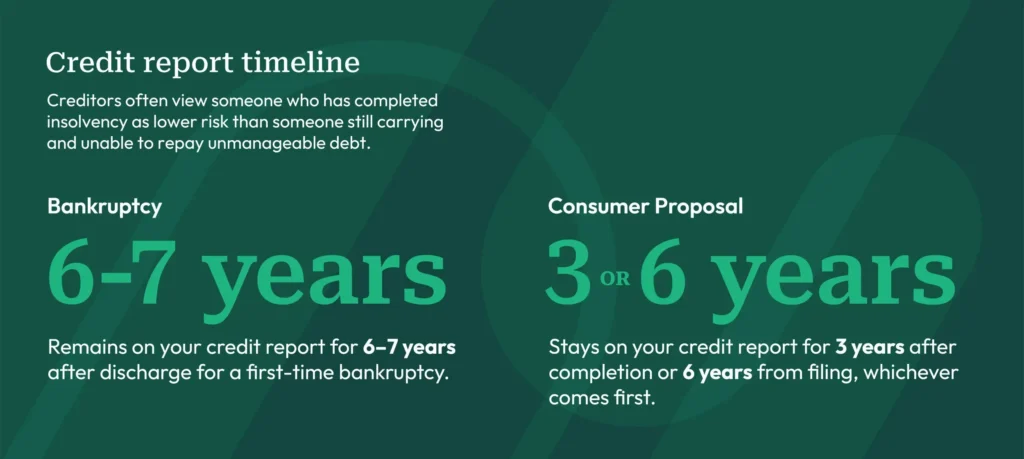
The reality of insolvency – why taking action is the first step to relief
Bromwich+Smith team
13 Jan, 2025
Debt can be scary. It’s tempting to want to run and hide when it becomes a problem, but delaying action will only make it worse. If you’re struggling with overwhelming debt in Canada, filing for insolvency—whether through a consumer proposal or personal bankruptcy—can provide the relief you need to take back control of your financial story. Often, the sooner you can act, the sooner you can begin rebuilding your credit and achieving your financial goals.
You may hear the term insolvency used when referring to debt, but what does it mean? Insolvency simply means not being able to make your debt payments when bills are due. To file for a consumer proposal or bankruptcy, you must show that you are insolvent or unable to make your payments.
The importance of acting now
Hesitation when facing financial challenges often stems from fear, shame, or uncertainty regarding the path forward. It’s normal to feel overwhelmed and unsure, but it’s important to know you’re not alone. 143,352 Canadians filed for a consumer proposal or bankruptcy in the last 12 months – that’s a 15% increase from the year before. Asking for help isn’t shameful. Reaching out is the first step toward relief.
- Immediate debt relief
Filing for insolvency will end collection calls, lawsuits, wage garnishments and growing interest charges. Acting sooner reduces the stress of creditor harassment and the debt that accumulates from high interest rates. The longer you wait, the more it will cost you - Time doesn’t stop until you take action
The insolvency process takes time. For example, a first-time bankruptcy filing typically lasts 9–21 months based on your income level. A consumer proposal will be spread over up to five years. Once your creditors have voted to accept your insolvency you will receive legal protection and your debt will be frozen and no additional fees will be added. The sooner you act, the sooner you can freeze additional charges - Regain emotional and financial well-being
Debt impacts more than just your wallet—anyone who has struggled with debt will be able to tell you that it takes a toll on your mental health, relationships and overall quality of life. The sooner you can start managing your debt the sooner you’ll be able to take the weight off your shoulders and get back to feeling like yourself again
One of the biggest concerns people have about filing for insolvency is how it will impact their ability to open new credit. While it’s important to know that filing insolvency will affect your credit score, you should remember that your credit is likely already damaged if you’re missing payments or defaulting on debts. A lowered score due to filing for insolvency isn’t forever as you’ll have the ability to grow and rebuild- but a lowered score brought on by missed payments will continue to decline until you do something about it.
Credit report timeline
- Bankruptcy: Remains on your credit report for 6–7 years after discharge (for a first-time bankruptcy)
- Consumer proposal: Stays on your credit report for three years after completion or six years from filing, whichever comes first
Creditors often view someone who has completed insolvency as lower risk than someone still carrying and unable to repay unmanageable debt.

Financing a car during and after insolvency
During insolvency
- Keeping your current vehicle: If you file a consumer proposal and you want to keep your financed car you’ll be required to continue making payments. If you file for bankruptcy and your car is deemed essential with a value that falls under provincial exemption limits, you may be able to keep it
- Obtaining a new car loan: While it’s more challenging to obtain financing during a debt relief program, some lenders specialize in working with individuals undergoing insolvency. Be prepared for higher payment terms and interest rates
After insolvency
- Rebuilding credit for better rates: Once you’ve completed the insolvency process, you may be able to renegotiate your payment terms for a lower interest rate. While it may feel like a small feat, paying off a secured credit card and ensuring bills are paid on time will demonstrate reliability to potential credit lenders
- Specialized lenders: Many lenders offer car loans to individuals post-insolvency, often with competitive rates if you’ve shown financial improvement. Your trustee likely has a list of lenders that have worked with clients previously
Getting a mortgage after insolvency
Homeownership may feel like an impossible dream after filing for insolvency, but it’s totally possible with effort and patience.
Impact of insolvency on mortgage approval
- Many larger lenders will require a minimum waiting period after insolvency which may be 2 years from discharge or proposal completion
- A strong credit score, stable income, and a sizeable down payment (often 20% or more) will improve your chances of qualifying
Steps to qualify for a mortgage post-insolvency
- Rebuild your credit: Use a secured credit card, pay bills on time and keep credit utilization low. Keep an eye on your credit report for any errors and report any discrepancies to your credit bureau
- Save for a down payment: Start saving as soon as possible to demonstrate financial responsibility
- Work with a mortgage broker: Brokers have seen every situation and will be there to work with you to find a lender who specializes in post-insolvency clients
Credit cards during and after insolvency
Credit cards play an essential role in rebuilding credit but obtaining one during or after insolvency may not be as easy as a few clicks online.
During insolvency
- It is likely that traditional credit cards are unavailable while you’re in bankruptcy or a consumer proposal
- Secured credit cards are a smart alternative. These cards require a deposit which is essentially the amount of credit you have available on the card. They act like regular credit cards and report activity to credit bureaus, helping rebuild your credit. If you are unable to make payments, your deposit will go toward the balance and your card frozen until the payment is paid in full and the original amount of the deposit is restored
After insolvency
- Start with secured cards or low-level credit cards intended for individuals rebuilding credit
- Use credit cautiously and pay the balance in full each month to demonstrate responsible spending habits
Why delaying action can make things worse
Ignoring creditors often complicates the problem. It will only increase the parade of phone calls and grow your debt.
- Debt spirals out of control interest rates, late fees, and penalties will make debt grow quickly. The longer you wait, the more challenging it becomes to resolve on your own
- Creditors may take legal action delaying action increases the chances of wage garnishments, lawsuits or asset seizures
- Mental and physical toll prolonged financial stress can lead to anxiety, depression and even physical health issues. Relationships often become strained and over time may fall apart
- Missed opportunities to rebuild every month spent postponing action is a month you could have spent improving your credit and rewriting your financial story
Signs to seek help
Knowing when to file for insolvency is essential, but the signs may not be as easy to see from the outside looking in.
- You can’t keep up with minimum payments: While it may appear to be a small thing, if you find yourself consistently falling behind it often signals unmanageable debt
- You’re borrowing to pay off debt: Using one credit source to pay another creates a dangerous cycle of debt
- Creditors are calling: Persistent collection efforts indicate your debts are overdue and need resolution. Talking to your creditors and being honest with your situation is hard, but hiding from the truth makes it more difficult to find a resolution that prioritizes you
- Stress is affecting your life: If debt is harming your mental health or relationships, it’s time to act. Maybe you’re avoiding social situations since you can’t afford them, or you’re avoiding friends or loved ones that you’ve borrowed money from
Professional guidance: your first step toward financial freedom
The process of filing for insolvency can feel overwhelming, but you won’t be doing it alone. Licensed Insolvency Trustees (LITs) are federally regulated professionals who specialize in helping Canadians resolve debt.
What LITs do
- Assess and review your financial situation
- Explain all debt-relief options, including alternatives to insolvency. You have the right to understand all options available to you even ones outside of filing insolvency
- Guide you through the process of filing for bankruptcy or a consumer proposal
- Act as a referee between you and your creditors. They’ll find a resolution that is based on what you can afford to pay and what your creditors are willing to accept
Consultations with an LIT are confidential and free, making them an ideal first step if you’re unsure where to start.
Moving forward: life after insolvency
Filing for insolvency is not the end of your financial journey—it’s going to be a new beginning. By tackling your debts now, you’re taking the first step towards a brighter financial story.
Tips for rebuilding
- Create a budget: Plan your spending, save for emergencies and avoid unnecessary debt. A budget should be reviewed regularly and updated if your income or expenses change
- Rebuild credit slowly: Use secured credit cards and pay them off on time
- Set goals: Whether it’s homeownership, car financing or growing your savings, work towards your short-and long-term goals
- Seek support: We trust professionals in other areas of our life, so why not trust a financial advisor, trustee or counsellors as experts to provide guidance as you rebuild
The time to act is now
Filing for insolvency is not a failure—it’s a positive solution to a growing problem. The sooner you address your debt, the sooner you can begin rebuilding your life and achieving your financial goals. If debt is holding you back, don’t wait, your debt free future can start now.


